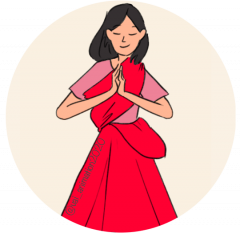“Animation is a powerful medium. Hence, enjoy the moment of creating something and indulge in everything you do.” – Bhimsain Khurana
AnimationXpressTeam (2017)
Quote sourced from: http://www.animationxpress.com/index.php/latest-news/bhimsain-khurana-an-energetic-and-zealous-man-who-constantly-inspires and https://www.toonz.co/toonz-news.html?id=60
Bhimsain was the lead animator on this film and he directed it alongside Vijaya Mulay, who is also a very well known female director, film historian, educationist, researcher and documentary filmmaker. This film was broadcasted on then satellite television channel called Doordarshan and was part of the three films that Vijaya Mulay was instructed to make on behalf of the Satellite Instructional Television Experiment (SITE). The Education Ministry of India had collaborated with NASA for this experiment.
According to Vijaya Mulay herself: “In the ’60s and ’70s, Dr. Vikram Sarabhai, who was looking after India’s space program and was anxious to develop distance communication satellite technology, managed to get NASA to agree to let India use their ATS satellite for one year. India was passing through very rough times at that time, as the United States for strategic reasons, with its Soviet phobia, was more allied with Pakistan than with India.
Why did NASA then agree to collaborate with us? I and many other Indians presumed that NASA probably agreed because it wanted to do many experiments that needed a large footprint for its satellite elsewhere since their own sky space was taken over by commercial interests. Communist countries, like Soviet Union and China, that had such space were out of the question as the United States considered communists as insufferable. Countries like Brazil and Indonesia that also had the requisite space then had very unstable governments at that time.”
This project was undertaken in partnership with Unicef and Vijaya Mulay was instrumental in making three educational films that touched upon ‘numeracy, literacy and affective sentiments’. Vijaya Mulay was then appointed as the head of the Centre for Educational Technology where upon she decided to complete the last and final film called ‘Ek Anek aur Ekta’.
She states that, “This is how the film “Ek Anek Aur Ekta” got done. I also experimented with the way the three films were made. “Ek, do” was made in black and white and was based on a song written by me and was all live action. “Na” was shot part live and part animation. The dialogue portion was in black and white, and the animation portion was in color. The third film, “Ek Anek Aur Ekta,” was in color and was an animation film.”
Not only did Vijaya Mulay script this film but she also directed it, keeping in mind to showcase a girl child as the main lead of the story. This comes as no surprise as she wanted to promote gender equality and women’s rights to education. She was married in 1940 (pre-independence), a time where women weren’t allowed to partake in the same professions or undertake education such as men. She wanted to change this ideology and it is wonderful to take note that she began doing so from the very start of her career.
She quotes, “A major feature of the patriarchy syndrome has been that only the male characters can be agents of action. The strong, intelligent and noble male acts; the passive woman usually suffers in silence”.
She was also friends with then Prime Minister Indira Gandhi, who happened to be the very first Female Prime Minister of India. As far as the socio political aspect of this film is concerned, there was a lot going on in India in the 1970s.
Excerpts taken from: https://india.blogs.nytimes.com/2012/05/18/the-cartoon-that-taught-indians-the-meaning-of-many/
My main focus is going to be on the politics of 1974.
- Students in Gujarat were protesting against the hike in food prices and essential commodities. The middle classes were also unified in supporting them due to concerns over rising inflation
- The state government’s lack of sympathy towards the issues of the masses and rifts within the state itself deepened the unrest felt by them
- The central government was unsupportive and the two governing bodies would often blame each other for the ensuing unrest.
- The government ended up repressing the situation, enforcing tough measures to control the growing agitation
- The movement solely became concerned with ousting the current state government when the opposing parties got involved
- The students in the higher positions ironically ended up succumbing to corruption
- They were also divided by their own mutual differences and failed to achieve long lasting positive results
- A similar movement occurred in Bihar, but it was far more violent in comparison
- In the end, President’s Rule was imposed on the state and in the following year a 2 year National Emergency was announced
India also conducted its first nuclear test in 1974, on 18th May in Pokhran and became the 8th in the world to conduct a peaceful nuclear test.
Websites: https://indianexpress.com/article/cities/mumbai/making-every-frame-count/
Academic Sources:
India in 1974: Growing Political Crisis https://www-jstor-org.arts.idm.oclc.org/stable/2643318?seq=3#metadata_info_tab_contents
Indian Cinema and the Bourgeois Nation State: https://www.jstor.org/stable/40277057?seq=3#metadata_info_tab_contents
From Rajah’s and Yogis to Gandhi and Beyond:Images of India in International Films of the Twentieth Century (Vijaya Mulay) book review by Richard John Ascárate: https://muse-jhu-edu.arts.idm.oclc.org/article/589150
